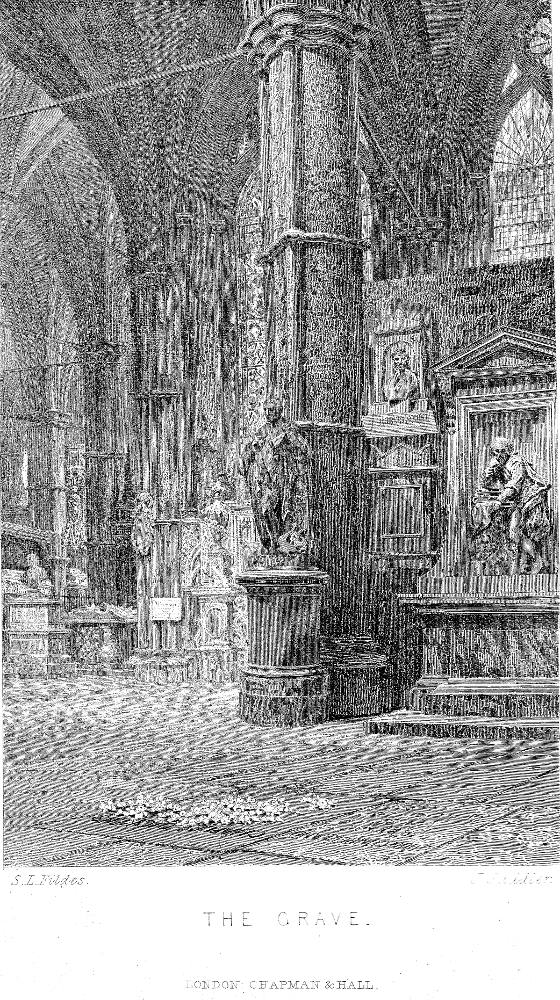

The Grave of Charles Dickens in Poets' Corner, Westminster Abbey by Sir Luke Fildes; engraver, J. Saddler, from a water-colour drawing for John Forster's Life of Dickens, facing p. 298 in Vol. II (1847-1870). Wood-engraving, 13.6 cm by 8.8 cm (5 ¼ by 3 ⅜ inches), framed. [Click on the image to enlarge it; mouse over links.]
Passage Illustrated: The Nation Mourns the Loss of Dickens at his Grave in the Abbey
With the expression thus given to a general wish, the Dean of Westminster lost no time in showing ready compliance; and on the morning of the day when it appeared was in communication with the family and representatives. The public homage of a burial in the Abbey had to be reconciled with his own instructions to be privately buried without previous announcement of time or place, and without monument or memorial. He would himself have preferred to lie in the small graveyard under Rochester Castle wall, or in the little churches of Cobham or Shorne; but all these were found to be closed; and the desire of the Dean and Chapter of Rochester to lay him in their Cathedral had been entertained, when the Dean of Westminster's request, and the considerate kindness of his generous assurance that there should be only such ceremonial as would strictly obey all injunctions of privacy, made it a grateful duty to accept that offer. The spot already had been chosen by the Dean; and before mid-day on the following morning, Tuesday the 14th of June, with knowledge of those only who took part in the burial, all was done. The solemnity had not lost by the simplicity. Nothing so grand or so touching could have accompanied it, as the stillness and the silence of the vast Cathedral. Then, later in the day and all the following day, came unbidden mourners in such crowds, that the Dean had to request permission to keep open the grave until Thursday; but after it was closed they did not cease to come, and "all day long," Doctor Stanley wrote on the 17th, "there was a constant pressure to the spot, and many flowers were strewn upon it by unknown hands, many tears shed from unknown eyes." He alluded to this in the impressive funeral discourse delivered by him in the Abbey on the morning of Sunday the 19th, pointing to the fresh flowers that then had been newly thrown (as they still are thrown, in this fourth year after the death), and saying that "the spot would thenceforward be a sacred one with both the New World and the Old, as that of the representative of the literature, not of this island only, but of all who speak our English tongue." The stone placed upon it is inscribed
Charles Dickens. Born February the Seventh 1812. Died June the Ninth 1870.
The highest associations of both the arts he loved surround him where he lies. Next to him is Richard Cumberland. Mrs. Pritchard's monument looks down upon him, and immediately behind is David Garrick's. Nor is the actor's delightful art more worthily represented than the nobler genius of the author. Facing the grave, and on its left and right, are the monuments of Chaucer, Shakespeare, and Dryden, the three immortals who did most to create and settle the language to which Charles Dickens has given another undying name. [Vol. II, "Westminster Abbey," pp. 297-298]
Scanned images and text by Philip V. Allingham. [You may use these images without prior permission for any scholarly or educational purpose as long as you (1) credit the person who scanned them and (2) link your document to this URL in a web document or cite the Victorian Web in a print one.]
Bibliography
Ackroyd, Peter. Dickens. London: Sinclair-Stevenson, 1990.
Bentley, Nicolas. "Dickens and His Illustrators." Charles Dickens 1812-1870: A Centenary Volume. London: Weidenfeld and Nicolson, 1969.
Cohen, Jane R. Chapter 18. Charles Dickens and His Original Illustrators. Columbus: Ohio State U. P., 1980.
Forster, John. The Life of Charles Dickens. In two volumes — with illustrations. The Charles Dickens Edition. London: Chapman and Hall, 1870. Vol. II (1847-70).
Mitchell, Sally, ed. Victorian Britain: An Encyclopedia. London and New York: Garland, 1988.
Schlicke, Paul, ed. Oxford Reader's Companion to Dickens. Oxford: Oxford Up. P., 1999.
Tomlin, E. W. F. "The Illustrators." Charles Dickens 1812-1870: A Centenary Volume. London: Weidenfeld and Nicolson, 1969.
17 July 2023